I noticed that the "cors" check takes longer than I expected. This has happened at different speeds from localhost, qa and production.
I am using axios (^0.18.0) that is using mobx/MST/reactjs and asp.net core api 2.2
I can have preflight options that range from a 20 milliseconds to 10 seconds and it will randomly change.
For instance I have
https://localhost:44391/api/Countries
This is a get request and it can take 20 milliseconds 9 times in a row (me ctrl + F5) but on the 10th time it decides to take seconds (I don't get seconds really on localhost but sometimes a second).
So this test, the 204 (cors request) takes 215ms where the actual request that brings back the data takes half the time. This seems backwards.
This is my ajax request
const axiosInstance = axios.create({
baseURL: 'https://localhost:44391/api/Countries',
timeout: 120000,
headers: {
contentType: 'application/json',
}})
axiosInstance.get();
Here is my startup. I made cors all open and wanted to refine it after I get this issue solved.
public class Startup
{
public IHostingEnvironment HostingEnvironment { get; }
private readonly ILogger<Startup> logger;
public Startup(IConfiguration configuration, IHostingEnvironment env, ILogger<Startup> logger)
{
Configuration = configuration;
HostingEnvironment = env;
this.logger = logger;
}
public IConfiguration Configuration { get; }
// This method gets called by the runtime. Use this method to add services to the container.
public void ConfigureServices(IServiceCollection services)
{
services.AddCors();
services.AddDbContext<ApplicationDbContext>(options =>
{
options.UseLazyLoadingProxies();
options.UseSqlServer(Configuration.GetConnectionString("DefaultConnection"));
});
services.AddIdentity<Employee, IdentityRole>(opts =>
{
opts.Password.RequireDigit = false;
opts.Password.RequireLowercase = false;
opts.Password.RequireUppercase = false;
opts.Password.RequireNonAlphanumeric = false;
opts.Password.RequiredLength = 4;
opts.User.RequireUniqueEmail = true;
}).AddEntityFrameworkStores<ApplicationDbContext>().AddDefaultTokenProviders();
services.AddAuthentication(opts =>
{
opts.DefaultScheme = JwtBearerDefaults.AuthenticationScheme;
opts.DefaultAuthenticateScheme = JwtBearerDefaults.AuthenticationScheme;
opts.DefaultChallengeScheme = JwtBearerDefaults.AuthenticationScheme;
}).AddJwtBearer(cfg =>
{
cfg.RequireHttpsMetadata = false;
cfg.SaveToken = true;
cfg.TokenValidationParameters = new TokenValidationParameters()
{
// standard configuration
ValidIssuer = Configuration["Auth:Jwt:Issuer"],
ValidAudience = Configuration["Auth:Jwt:Audience"],
IssuerSigningKey = new SymmetricSecurityKey(
Encoding.UTF8.GetBytes(Configuration["Auth:Jwt:Key"])),
ClockSkew = TimeSpan.Zero,
// security switches
RequireExpirationTime = true,
ValidateIssuer = true,
ValidateIssuerSigningKey = true,
ValidateAudience = true
};
});
services.AddAuthorization(options =>
{
options.AddPolicy("CanManageCompany", policyBuilder =>
{
policyBuilder.RequireRole(DbSeeder.CompanyAdminRole, DbSeeder.SlAdminRole);
});
options.AddPolicy("CanViewInventory", policyBuilder =>
{
policyBuilder.RequireRole(DbSeeder.CompanyAdminRole, DbSeeder.SlAdminRole, DbSeeder.GeneralUserRole);
});
options.AddPolicy("AdminArea", policyBuilder =>
{
policyBuilder.RequireRole(DbSeeder.SlAdminRole);
});
});
// do di injection about 30 of these here
services.AddTransient<IService, MyService>();
services.AddSingleton(HostingEnvironment);
services.AddMvc().SetCompatibilityVersion(CompatibilityVersion.Version_2_1);
services.AddTransient<IValidator<CompanyDto>, CompanyDtoValidator> ();
services.AddTransient<IValidator<BranchDto>, BranchDtoValidator>();
services.AddTransient<IValidator<RegistrationDto>, RegistrationDtoValidator>();
JsonConvert.DefaultSettings = () => {
return new JsonSerializerSettings()
{
NullValueHandling = NullValueHandling.Ignore,
MissingMemberHandling = MissingMemberHandling.Ignore,
ContractResolver = new CamelCasePropertyNamesContractResolver()
};
};
}
// This method gets called by the runtime. Use this method to configure the HTTP request pipeline.
public void Configure(IApplicationBuilder app, IHostingEnvironment env)
{
if (env.IsDevelopment())
{
app.UseDeveloperExceptionPage();
}
else
{
app.UseHsts();
}
//TODO: Change this.
app.UseCors(builder => builder
.AllowAnyOrigin()
.AllowAnyMethod()
.AllowAnyHeader()
.AllowCredentials());
app.UseHttpsRedirection();
app.UseAuthentication();
app.UseMvc();
}
}
I don't know if this is a valid test, but it does mimic what I am seeing in qa/production at random times.
I changed the axios request to ...
const axiosInstance = axios.create({
baseURL: 'https://localhost:44391/api/Countries/get',
timeout: 120000,
headers: {
contentType: 'application/json',
}})
axiosInstance.get();
basically I put /get, which causes a 404
Yet, when I refresh my page with the exact same scenario it is completed in milliseconds again (though still slower than the 404)
Edit
I made a hosted site nearly identical to my real site. The only difference is this one is only using http and not https.
It is not as slow as my real site, but the preflight right now can take 40ms while the real request takes 50ms.
I am testing it in latest version of chrome and you will have to load up the network tab and load/click the button (no visual output is displayed).






